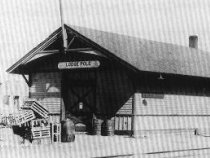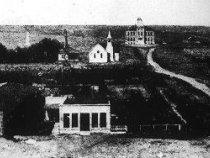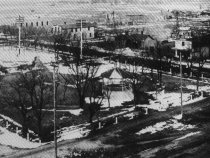Gurley
Cheyenne County
Gurley
Cheyenne County
The town of Lodgepole recognizes three important days in her history. The town's founding in 1867, filing the plat in 1884, and its incorporation in 1901. The town has strong ties to railroading and farming. The history of the town begins with the laying of the Union Pacific Railroad's track across the plains. It followed the Platte River across Nebraska and then went up Lodge Pole Creek valley into Wyoming. On July 7, 1867, the tracklayers reached a point in western Nebraska where a work station was needed. It was marked out and named "Lodge Pole" after the creek. Many Lodgepole-buffs claim the creek got its name because the Indians cut the long, straight, spindly teepee poles from along its banks -- thus Lodge Pole. Prior to 1867, the nearest thing to a settlement was "Pole Creek No.2 Pony Express Station," believed to have been located at the north end of Phil Quinn's hay meadow. For the first ten years, the town was entirely a railroad community, consisting of workers living in outfit cars, water and coal stations, a depot, and a detachment of U.S. soldiers stationed in an entrenchment to protect the railroad, its people, and their belongings from Indians. At that time the non-Indian population in that part of the country was confined to "ranches" along the Oregon and California trails which catered to the travelers, employees of the Overland Stage Company stations, plus the railroaders. The first record of any business, other than the railroad, was in 1876, when Charles Morton opened a dry goods and grocery store then filed a form with the U.S.Postal Service asking to establish a post office. Pat Barrett, whose father was a foreman with the U.P., remembered back in 1878 when he was eight, that "...the whole town consisted of the depot, a tie house, and a sod house." Another railroad agent, R.C.Cowdin, started a store in 1878. In the 1870s a few ranchers began running cattle on the lush grass. In 1883 Dr. Edwin Yarletz and family arrived and for the next 25 years, the Good Doctor and his horse and buggy was a part of our town. Other early families included Wolfe, Barrett, Fenske, Withers, Minshall, Kidney, Lehmkuhl, Drake, Young, Mettey, Bowser, Durkee, Pensinger, and Bates. With the platting of the town in 1884, the year the homesteaders began taking land in the area, the town began to grow. In 1895 the post office officially changed to the one-word name, "Lodgepole." The railroad, however, continued to use the old spelling until just a few years ago. Lodgepole's main street moved three different times in the early years. Most of the early business houses were built predominantly of stone from two nearby stone quarries, slip-form concrete, or brick. The town council passed an ordinance that prohibited building any business of anything but the aforementioned materials, due to so many fires in frame buildings. Lodgepole was incorporated in 1901, and as part of the new status, miles of concrete sidewalks were poured. The Union Pacific started the south park in the area between the railroad and Front Street, furnished a caretaker to get the trees and grass started, and laid out walks through the park. The town started the north park between the railroad and Sheldon Street across from the railroad park. Lodgepole was blessed with several nice hotels. The Nash Hotel's claim to fame was that Teddy Roosevelt often stopped there while in town to ship cattle from his Dakota ranch, or just to catch the train. Lodgepole's population peaked in about 1925 at 880. Today there are close to 500 friendly neighbors and friends that share this spot on the map. Farming is the main occupation in the surrounding territory. There continues to be a close tie between farmers on the level tablelands to the north and south, and business people of the town. Lodgepole has a good business district, three churches, several fraternal organizations, women's groups, and maintains a class D school district.
By Horace W. (Hort) Quinn, Box 205, Lodgepole, NE 69149 |
 Union Pacific Depot in Lodgepole, 1921, Dick Miller agent at freight cart.  Looking north from Sheldon & Oberfender Street, 1909.  The new U.P.Railroad park and band stand, 1908, taken from on top of their water tower looking south. On front street from left: W. Minshall residence, his ice house, Lew Debrunner's bar, Park Hotel, post office, Wm. Tate Real Estate, Barlow & Wyatt Dry Goods, Claude Moorehead residence on corner. In background is Harris and Johnson homes. |